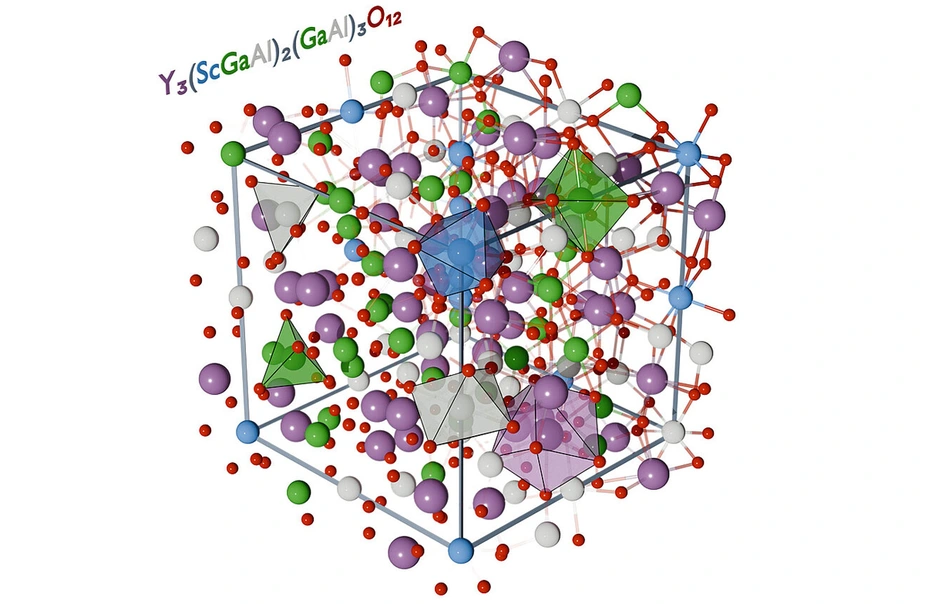YSGAG: A Breakthrough Substrate for Quantum Magnonics from IKZ
New material allows quantum experiments at low temperatures
Dr. Christo Guguschev and his team from the Leibniz-Institut für Kristallzüchtung (IKZ), in collaboration with international partners, has developed and demonstrated a new diamagnetic substrate material, nearly perfectly lattice-matched to the model ferrimagnet of magnonics—yttrium iron garnet (YIG).
Unlike the previously used paramagnetic substrates, the new material, yttrium scandium gallium aluminum garnet (YSGAG), remains magnetically inert even at temperatures approaching absolute zero. This property allows YIG thin films to retain their exceptional magnetic quality and ultralow damping at millikelvin temperatures, enabling quantum experiments with the same outstanding performance as at room temperature.
Yttrium iron garnet (YIG) is a cornerstone material in spintronics and magnonics due to its exceptionally low magnetic damping, which allows the propagation of spin waves—collective excitations of the magnetic system—and their quasiparticles, magnons, over long distances. For applications in radio-frequency technology and magnon-based unconventional or quantum information processing, YIG must be fabricated as thin single-crystal films with thicknesses ranging from tens of nanometers to several micrometers.
At room temperature, gadolinium gallium garnet (GGG) has long been the standard substrate for epitaxial YIG growth, providing excellent lattice matching and film quality. However, GGG becomes paramagnetic at low temperatures, and in the presence of external magnetic fields, necessary to enable and control spin waves, it becomes partially magnetized. This leads to inhomogeneous stray fields that strongly disturb the magnetic uniformity of the YIG layer. Together with a resulting magnetic coupling between magnetized substrate and film, this introduces additional dissipation channels, drastically shortening magnon lifetimes and making such systems unsuitable for quantum experiments.
This long-standing bottleneck in quantum magnonics—a field exploring the quantum properties of magnons and their application in quantum information technology—has now been overcome by a collaborative international effort.
Dr. Christo Guguschev from IKZ developed the novel YSGAG substrate crystal, a diamagnetic, lattice-matched garnet that avoids substrate magnetization at millikelvin temperatures. Dr. Carsten Dubs from INNOVENT e.V. Technologieentwicklung then grew the highest-quality YIG films on these substrates using liquid-phase epitaxy (LPE). The samples were subsequently microstructured at CEITEC in Brno and characterized at millikelvin temperatures by teams at RPTU Kaiserslautern and the University of Vienna. The measurements confirmed that YIG grown on YSGAG maintains its exceptionally low damping and long magnon lifetimes down to the lowest temperatures achievable in dilution refrigerators.
This major materials breakthrough, currently under patent application, provides a practical pathway toward ultralong-lived magnons in thin films. It paves the way for scalable quantum magnonics with coherent magnon transport, strong magnon–photon and magnon–qubit coupling, and the development of integrated quantum networks.
The work was supported by the Federal Ministry of Research, Technology and Space (BMFTR) under the reference numbers (13N17108, 13N17109 and 13N17110) within a collaborative project “Low-loss materials for integrated magnonic-superconducting quantum technologies (MagSQuant)” and funded in part by the Austrian Science Fund (FWF) project Paramagnonics (10.55776/6568).
Contact:
Leibniz-Institut für Kristallzüchtung (IKZ)
Dr. Christo Guguschev
+49 (0) 30 246499-417
christo.guguschev(at)ikz-berlin.de
www.ikz-berlin.de
IKZ press release, 24 October 2025
